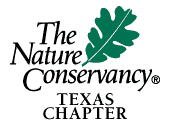|
|
|
|  From the Fall '99, Volume 24, No. 2 Issue of Horizon From the Fall '99, Volume 24, No. 2 Issue of HorizonStory and photos by Rick Turner Staff Ecologist Reprinted by permission of The Nature Conservancy of Texas, copyright 2000
In February 1998, a storm with wind speeds of hurricane force raked across central East Texas, causing extensive damage to forests across the region. The damage was especially severe in the Angelina and Sabine national forests. More than 100,000 acres of national forest land were affected by the storm, and an estimated 10,000 acres were extensively damaged. Much of the damage occurred in areas managed as habitat for the endangered red-cockaded woodpecker (Picoides borealis). Many of the birds' nest trees were destroyed by the storm, and since this species constructs its nests only in mature, living pine trees, the loss of timber was significant. Habitat for several rare plant species, including southern lady's-slipper orchid (Cypripedium kentuckiense), slender wake-robin (Trillium gracile) and Mohlenbrock's umbrella sedge (Cyperus grayioides), was also affected. At first glance, the damage might seem to have destroyed these forests, but in the extensively damaged areas the storm has provided a unique opportunity to "start over" - that is, to restore the landscape to more closely resemble the natural ecosystems once supported here. The uplands of East Texas were logged of their old-growth forests by the early part of this century. Afterward, much of the land was converted to agricultural uses, but most was subsequently abandoned during the Great Depression of the 1930s. Shortly thereafter, the Angelina and Sabine national forests were established on this altered landscape. The plant communities that have grown up on the abandoned fields now are often quite different in species composition from the original forests. The suppression of natural fires on the upland landscape has resulted in further changes in plant communities. To aid in the restoration and reforestation effort, The Nature Conservancy of Texas worked with U.S. Forest Service staff to produce an ecological map of the entire windstorm area using an ecosystem model recently developed by the Conservancy. The Ecological Classification System (ECS) was developed by collecting soil, landform and vegetation data from natural plant communities and analyzing them using sophisticated mathematical techniques. The result of the five-year project is a model that predicts the natural plant communities on the landscape as influenced by important environmental factors, regardless of the condition of the current vegetation. To create the ecological map, databases containing soil and landform information were analyzed in a computerized mapping program known as a geographic information system (GIS), which divided the landscape into ecological units called landtype phases. Each landtype phase has soil, landform and vegetation characteristics that distinguish it from other landtype phases. Ecologists tested the accuracy of the GIS map by visiting areas on the national forests and comparing them with their mapped landtype phase designation. The completed map is being used by national forest managers to help select the appropriate tree species and the reforestation techniques needed to restore natural communities to damaged areas on the landscape. It is also being used to locate additional areas of undamaged forest that are ecologically suitable for managing red-cockaded woodpecker habitat. As the U.S. Forest Service moves toward ecosystem management of national forest lands, the information provided by the ECS is proving to be an important tool in making ecologically sound management decisions. The windstorm provided an excellent opportunity to integrate ecological information into restoration planning and to refine and test the process of mapping ecosystems on the national forests. The long-term goal is to apply the mapping methods developed in the windstorm area to all of the national forests in Texas, which will serve to promote the protection and restoration of biodiversity on these important public lands. |
|
Send mail to johndenverfon@aol.com with questions or comments about this web site. Last modified: June 25, 2000 |